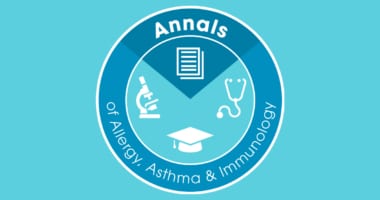 Most of us in North America are in the midst of the summer heat. This has made indoor (or at least shaded outdoor) activities a must for most of us. I can think of no better way to spend this time than having your favorite cool beverage while perusing the pages of the July issue of the Annals of Allergy, Asthma and Immunology. Although the emphasis for this month is drug allergy, in keeping with our efforts to provide something for everyone in every issue, I want to call your attention to a few articles that will expand your thinking.
Most of us in North America are in the midst of the summer heat. This has made indoor (or at least shaded outdoor) activities a must for most of us. I can think of no better way to spend this time than having your favorite cool beverage while perusing the pages of the July issue of the Annals of Allergy, Asthma and Immunology. Although the emphasis for this month is drug allergy, in keeping with our efforts to provide something for everyone in every issue, I want to call your attention to a few articles that will expand your thinking.
The first, by Harold Kim, MD and his group from Canada, describes evidence for utility of point-of-care ultrasonography as a clinical office tool for allergists-immunologists. They describe the utility of this procedure in ensuring adequate epinephrine injection in anaphylaxis to minimize the risk of intramuscular subcutaneous immunotherapy with adverse side effects and in intralymphatic immunotherapy and biologic injections. The authors believe that point-of-care ultrasonography can be a useful tool to enhance patient care and safety in an allergy clinic. Ideally, all patients prescribed an epinephrine autoinjector should have ultrasound measurement of the skin to muscle distance and skin to bone distance to assist in identifying patients at risk of subcutaneous or intraosseous injection in anaphylaxis and/or intramuscular risk during SCIT.
Don’t miss out on these other great articles from Annals:
Remember to read our Perspectives articles. These are succinct, evidence-based opinions from thought leaders. One article to read is written by our Advocacy Council members led by Allen Meadows, MD, FACCAI. They use the example of venom immunotherapy shortages to remind us of the payment structure from medical services currently available in the United States. This is advanced as the basis for the thin financial margin traditionally experienced by allergists and, with the recent reduction in venom immunotherapy supplies, questions the impact on continuing to deliver this service to affected patients.
Another Perspective article addresses issues associated with the controversial topic of maintenance of certification (MOC) to maintain our board status. Mitchell S. Grayson, MD, FACAAI and his group from Columbus, OH make an evidence-based case for the validity and value of the MOC program currently offered by the American Board of Allergy and Immunology (ABAI). They describe the efforts of ABAI members to develop a diverse program that addresses the expertise of a spectrum of providers, from practicing allergists to clinical immunologists. The ABAI MOC program provides credit for many of the activities, such as journal review, participation in local, regional, state and national society work, etc., to the individual diplomate. This article provides useful information to assess our own nonclinical-based activities many of us do in support of our profession and encourages other to get engaged. There is credit available for these activities.
Have a great summer and happy reading! I hope you will enjoy this and other features of this month’s Annals. As always, your feedback is always welcome.
Gailen D. Marshall, Jr., MD PhD FACAAI
Editor-in-chief

